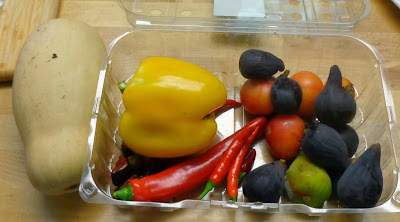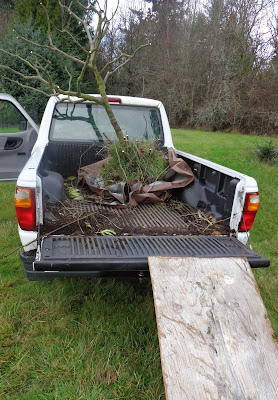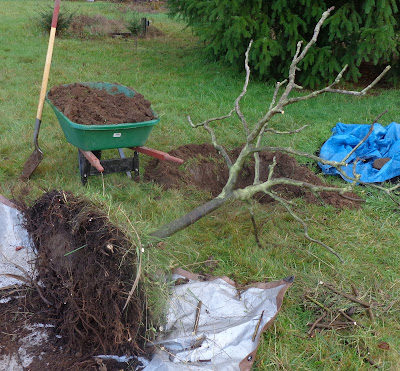This was as big as I can handle. I grew this tree from a cutting in 2001. It came from a NoID tree in a vacant lot. I have been calling it "Vancouver" because I don't have a solid ID. I'm fairly sure the variety is Brunswick = Dalmatica = Magnolia = Madonna. The figs are big, juicy, and sweet, but I lose most of the crop every year due to lateness. Most of the figs fail to ripen in the cool wet late October weather. I debated cutting it down. Instead, I moved it to the Battleground place. There, it ill have more sun, and maybe a little brighter sun. Maybe that will ripen the figs a little sooner.
This location was becoming unkept, and so was the tree. First I pruned the suckers and pruned the top to make it easier to handle. I pruned a bit more aggressively than I usually do. It will lose all breba (summer figs). That's OK. Almost all of the breba crop falls off anyway. That might make it produce more and earlier main crop (fall figs). Or not.
I'm thinking that with the digging, I'll lose a fair amount of root, so the top also needed to be reduced. Figs have a very fibrous root system that spreads laterally, but doesn't seem to extend very deep. I think the top should regenerate OK. I was happy with the open center shape that I gave the tree with years of careful pruning.
I also pruned back all of the suckers. I want to keep the open center structure, and have a single trunk. The single trunk is easier to wrap with Tanglefoot to keep ants out of the figs.
It takes a lot of digging to move such a big tree. I started about 2 feet from the trunk. after digging an 18n inch deep trench, it took more than an hour of slicing under the tree with the shovel, to free it from the underlying soil. Not a lot of roots going deeper. I had to prune 3 or 4, finger sized roots. That's my fat fingers, not dainty fingers. But still not a lot of big root was lost.
With heavy trees and shrubs, it helps to work a tarp under the root ball, and pull it around by the tarp. Less damage to tree and roots. It also helps to have a plank to slide the tree up onto the truck, and back down to the ground. Much easier on the back.
Now at the Battleground place. There was a break in the rain. The soil is a bit wetter than I like to dig in. Wet makes it heavier and higher risk for compaction. I was careful to keep it from compacting.
I'm always surprised, after digging under trees, to see that most of the roots don't go deeper. In my imagination, the roots are a deep as the tree is tall. That is not the case.
Torn and broken branches and roots tidied up, with cleaner pruning slices.
Most of the weight was the accompanying soil. I'm guessing 200 pounds. This was heavy, hard work. Words were said. I dug an ample hole, planted, settled the tree in, and applied a donut of straw mulch. A little more trimming, cut the suckers closer to the trunk, and the branches to outward facing buds. It's ready for winter, and then next year. We'll know then if I killed it. I don't think I did.





















































